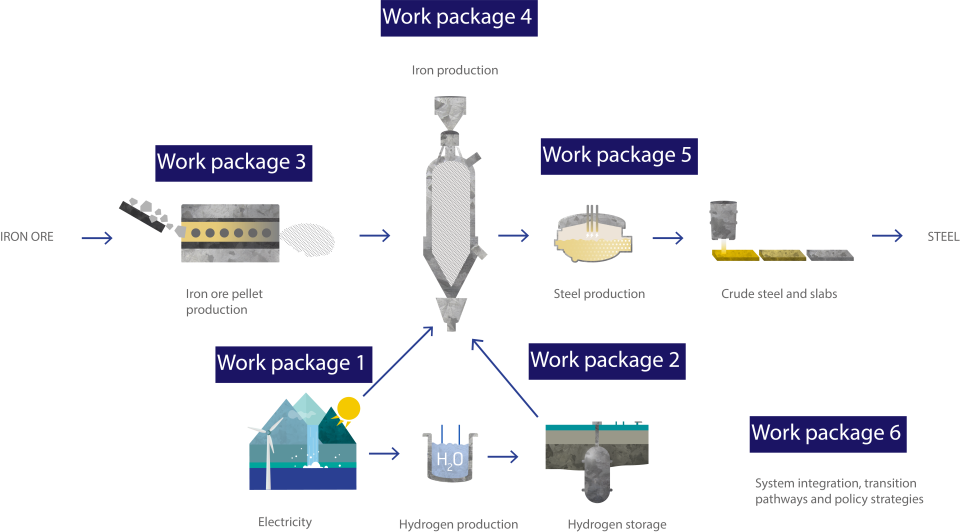Using hydrogen instead of carbon during the reduction of iron ore to iron is the most sustainable and technically promising option for the iron and steel industry. A switch to hydrogen would mean major changes in the energy system, iron ore refining and steel production. HYBRIT is developing the technology and the value chain for hydrogen-based iron and steel production for a fossil-free future.
In early 2017, a four-year research program was launched, which took the initial steps towards achieving the long-term goal of producing fossil-free steel. The development work has been conducted with the support of the Swedish Energy Agency. These results have been important when HYBRIT took further steps towards development in the pilot and demonstration scale, and were summarized during 2021. The program included both practical laboratory-scale trials and analyses in several different fields of research.
The aim of HYBRIT’s research is to investigate and evaluate possible ways to make the value chain for energy-iron-steel fossil-free and, thus, provide a foundation for future industrial strategies. This will be a transition in which the industry will have to work together with policy makers, consumers and other stakeholders. This gives Sweden a unique position, and responsibility, to take the lead in the transition to fossil-free iron and steel production.

HYBRIT’s research program was divided into different work packages. Below, you can learn more about our different areas of research along the road to fossil-free iron and steel production.
In our research library you may download and read the articles that have been published regarding the different work packages.
Supply of fossil-free electricity and the effects on the electricity system
Evaluating the conditions for the supply of fossil-free electricity, including by simulating the effects of the HYBRIT concept on current electrical systems. The project also looked at the opportunities for supporting the transition to fossil-free electricity generation by balancing the system and ensuring stability in the electricity grid. How production costs and flexibility are affected by the installed capacity for hydrogen production and storage was also analyzed.
The work package’s partners are Vattenfall with the support of LKAB and SSAB.
Production and storage of hydrogen
Developing a value chain for the efficient and safe production of hydrogen. The renewable energy used provides safe, sustainable and cost-effective access to hydrogen. It is investigating the conditions needed for the production of hydrogen on an industrial scale for use in the value chain for fossil-free steel. One important parameter for the cost-effective production and use of hydrogen is the ability to store it. Storing hydrogen provides an opportunity to stabilize the energy system by producing hydrogen when there is plenty of electricity, for example when it is windy, and using the stored hydrogen when the electrical system is under strain. The project also investigated questions about material selection and solutions for safe underground storage.
The work package’s partners are Vattenfall and KTH.
Production of fossil-free iron ore pellets
Creating the conditions needed for the fossil-free production of iron ore pellets in processing plants. The project investigated the opportunities and effects of different heating methods to replace the fossil fuels used today. The sub-project also evaluated the opportunities for increasing the efficiency of energy and raw material use throughout the entire system between pellet production and reduction of iron.
The work package’s partners are LKAB, Luleå University of Technology, Swerim and RISE ETC with the support of Vattenfall and SSAB.
Hydrogen-based reduction of iron ore
Studying how the iron oxide in the iron ore can be reduced by hydrogen-based technologies. The idea is that these will replace today’s technology that is based on the use of carbon and coke. The project investigated the effects of the properties of the reduction gas as well as how to handle the sponge iron that is created in the reduction process.
The work package’s partners are LKAB, KTH, Luleå University of Technology with the support of Swerim and RISE ETC.
Steel production of hydrogen-reduced iron ore
Studying how the product that is the result of the direct reduction process – sponge iron – can be smelted in electric arc furnaces for use in the steel making process. The project is investigating how different components react in the process and can be handled, as well as the extent to which today’s electric arc furnaces need to be further developed for this new production process.
The sub-project’s partners are SSAB and KTH with support from LKAB and Luleå University of Technology.
Meeting the market
Investigating ways and strategies to realize the transition to hydrogen-based iron and steel production with fossil-free energy. Such a transition requires changes in both technical systems and integrations as well as in business models. The work package is analyzing the intersections between technology, infrastructure, markets and society at large; for example, how regulation and forms of support affect the opportunities for transition.
The work package’s partners are Lund University, Stockholm Environment Institute (SEI) and Swerim with support from SSAB, LKAB and Vattenfall.